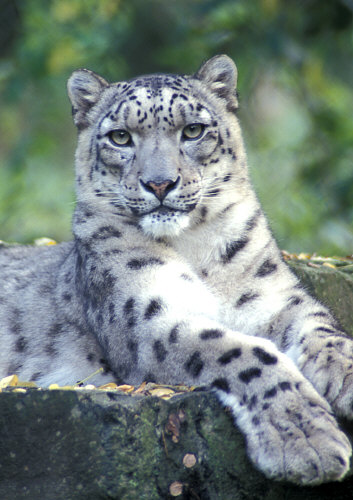Snow Leopard

- The snow leopard is mainly distributed among Western Mongolia to NE Pakistan and Bhutan and Eastern Asia.
- The snow leopard has a nice, thick coat to help it adapt to the grasslands, its surroundings. The surfaces of the snow leopard's paws are entirely covered by a cushion of hair. It has a long, swift tail that stretches around its whole body. The snow leopard contains a tint of white, unlike other leopards, and has many dark-colored spots which help it camouflage in its ecosystem
- Although some may have a voice, or squeak, the snow leopard has a low growl which may scare prey and even some predators.
- Males and females mate in the late winter, and after a certain period which consists of 93-103 days, one to four young are born. The young open their eyes when they are 7-9 days old, and remain with their mother for the remaining winter and spring.
Most snow
leopards basically stay in the grassland biome where there is proper
rainfall for itself (25-75 cm/year). Within this biome, the snow
leopard survives near high mountain slopes, near the treelines. It also
lives in dense thickets, crevices in rocks, or in caves. This carnivore
does most of its chores during the daytime and in the nightime it will
catch up on its rest.
The snow leopard's coat varies in thickness from summer to winter. A thicker coat, called prime, develops to help insulate itself during the winter. The surfaces of its paws are covered by a cushion of hair for excellent traction in snow and ice. These animals usually stalk their prey and later spring upon it. The snow leopard has a long tail to enable it to maintain better balance and accomplish more accurate jumps. Also, its tint of white helps it blend in and camouflage with its snowy winter environment. Its large ears help adapt to life in the cold Himalayas. Always shy and wary, with keen senses, the leopard's ability to hide makes it harder to track down than a lion or tiger.
ThreatsThe primary threats to the species are illegal hunting and the sale of pelts, bones and body parts for the fur-trade and traditional Chinese medicine; the depletion of the natural prey base; retribution by herders for depredation of livestock; lack of awareness of the importance of protecting snow leopards among villagers; and habitat degradation along with habitat fragmentation.
Endangered
Total numbers crudely estimated at
4,500-7,500. Sparsely distributed across 12 countries in Central Asia:
China, Bhutan, Nepal, India, Pakistan, Afghanistan, Tajikistan,
Uzbekistan, Kyrgyzstan, Kazakhstan, Russia, and Mongolia. Preferred
habitat: steep, broken mountains in the alpine and subalpine zone where
vegetation is sparse. Home range varies from about 10 square miles in
prey-rich habitat to over 800 square miles in parts of Mongolia where
prey densities are much lower. The total potential range covers some
1.5 million square miles, but it is unknown how much of that is
actually occupied by snow leopards.
